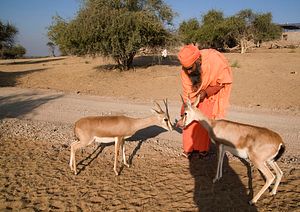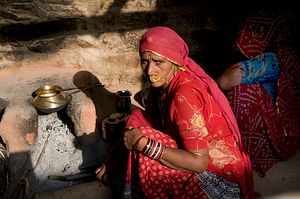In 1485, the Bishnoi tradition was born in the hands of Guru Jambeshwar, a Rajput chieftain of Marwar, in western Rajasthan. He formulated 29 commandments, which a Bishnoi is expected to follow until death. Of these, six are extraordinary – they cover environmental protection and compassion for all living creatures. The Bishnoi are commanded to provide shelter for abandoned animals and prohibited to cut down trees; they follow a system of sharing resources with the wildlife around them.
If this ancient religious creed — which is, at its core, environmentalism — is surprising enough, the way the Bishnoi have adhered to the principles is no less so. For centuries, they have lived and died for them. In 1730, in the remote village of Khejarli in western Rajasthan, 363 Bishnoi men, women, and children sacrificed their lives trying to protect hundreds of Khejri trees that the king’s men had come to cut down to fuel the cement lime kilns for the king’s palace. The ancient creed has translated into modern activism. The Bishnoi fiercely protect the endangered wildlife that lives around them and every year a few of them lose their lives to poachers. In 1998, they chased down and caught Salman Khan, the Bollywood superstar who had killed a couple of blackbucks in the dead of the night. The cine idol has been sentenced to five years imprisonment, courtesy of the relentless agitation of the Bishnois in the face of fierce opposition from different influential quarters.
More recently, the Bishnoi have led a movement against a nuclear power plant in Haryana. The site is a critical natural habitat for blackbucks and the Bishnoi have been demanding an adequate conservation plan for wildlife. They intend to carry on as environmental vigilantes, a role they have played for more than five centuries.
Sugato Mukherjee is a photographer and writer based in Calcutta. His works have appeared in The Globe and Mail, Al Jazeera, National Geographic Traveler, Harper Collins and Yale University Journal. His coffee table book on Ladakh has been published from Delhi in 2013. Some of his visuals and stories can be found at sugatomukherjee.zenfolio.com












































